More On Pav Bhaji
Pav bhaji is an iconic dish from Mumbai and hugely popular all over India as a street food. It first originated in Mumbai as a quick lunch option for textile mill workers.
Gradually this dish becomes so popular that now it is served as street food as well as in restaurants in Mumbai and the rest of India.
In Hindi and Marathi languages, the word “Pav” is for bread rolls. “Bhaji” means vegetables or a vegetable based dish (dry or gravy) in the Marathi language. Since both the bhaji (vegetable gravy) and pav (dinner rolls) are served together, hence the name ‘Pav Bhaji‘.
Bhaji is basically a mix of mashed and spiced vegetables in a tangy flavorful spiced gravy. A special spice mix called ‘Pav Bhaji Masala‘ is used to make this dish. Pav bhaji masala powder is easily available in Indian stores and online but can be made at home too.
Keep in mind that the best taste of the bhaji comes from using the perfect and best pav bhaji masala. I highly recommend to include your favorite brand or make your own homemade pav bhaji masala.
If you love Mumbai pav bhaji like us, you could have a look at this savory, spiced stuffed dinner rolls known as Masala Pav which is also a street food.
More On My Recipe
My recipe traces back to my teens when I would make this delightful dish for my parents and sister. Whenever we would go to Juhu beach in Mumbai, pav bhaji was one snack we would always gorge upon.
I have fond memories of savoring pav bhaji and other Mumbai street food snacks in my childhood at Juhu beach. And it is from this place that I have picked up the fine nuances and inspiration of making this decades old recipe.
To make my version, specifically the bhaji – onion, ginger-garlic paste, tomatoes, are sautéed in butter first. Later to which boiled and mashed vegetables are added followed by pav bhaji masala.
The bhaji or vegetable gravy is simmered for some minutes and served steaming hot with buttered and lightly toasted bread rolls.
While in the streets and in restaurants, they make pav bhaji on a large flat tawa (a flat skillet). But when making at home you can easily use a wok (kadai) or skillet or a frying pan.
Ingredients You Need
- Mix Vegetables. I add a mix of veggies like cauliflower, carrots, potatoes, capsicum and green peas. The Mumbai street side versions do not have carrots, but I add them for health reasons. They also add very less amount of cauliflower and sometimes omit it completely.
- Green Peas. I always add fresh or frozen green peas. The street side bhaji has dried green or white peas which are cooked and mashed. The dried green peas give a different taste and consistency to the bhaji. Feel free to include dried green peas in this recipe.
- Butter. I personally prefer to use the Indian brand of Amul butter for the bhaji, but you could use any brand or even white butter.
- Pav Bhaji Masala. This is a special spice blend that is added into the bhaji. Either buy a good brand of make your own following my recipe of Pav Bhaji Masala.
- Pav (Dinner Rolls): Pav are soft, fluffy dinner rolls. For the pav you can either make them at home or buy from a good bakery. I usually make Pav a day before when I decide to make this dish or when I have Misal Pav on the menu. For health reasons, you can opt for whole wheat dinner rolls.
How to make Pav Bhaji
Cook Vegetables
1. Rinse, peel and chop the veggies. You will need 1 cup chopped cauliflower, 1 cup chopped carrot, 3 medium sized potatoes (chopped) and ⅓ cup chopped french beans.
NOTE: You can also add veggies that you like, but do not add okra, eggplants, pumpkin, radish, corn, yam or green leafy vegetables.
Cabbage, broccoli, zucchini, pumpkin are some unique options that you can consider to add, but the traditional version does not include these veggies.
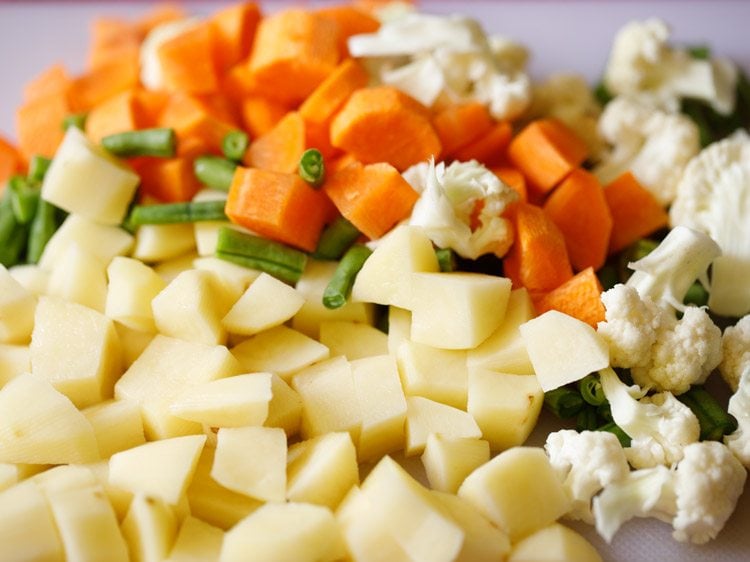
2. Add all the above chopped veggies in a 3 litre pressure cooker. Also add 1 cup green peas (fresh or frozen).
I have cooked the veggies in a pressure cooker. You can boil or steam them using a pan or in the Instant pot adding water as needed.
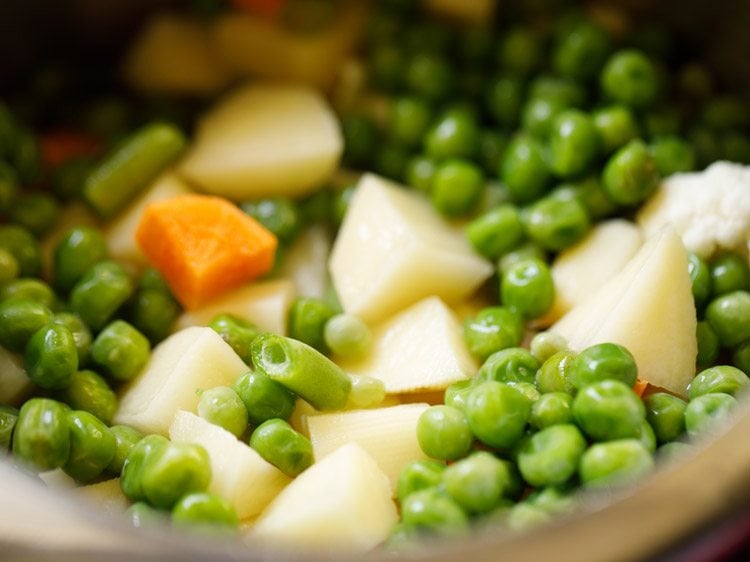
3. Add 2.25 to 2.5 cups water.
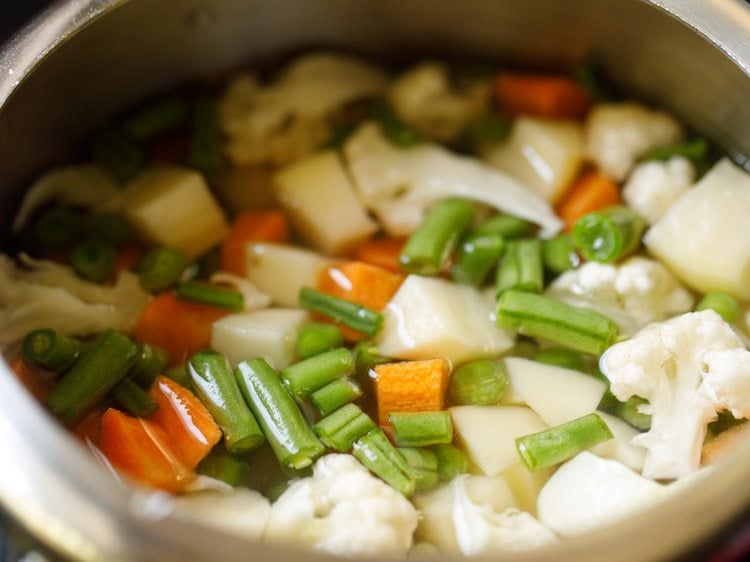
4. Pressure cook the veggies for 5 to 6 whistles or for about 12 minutes on medium heat.
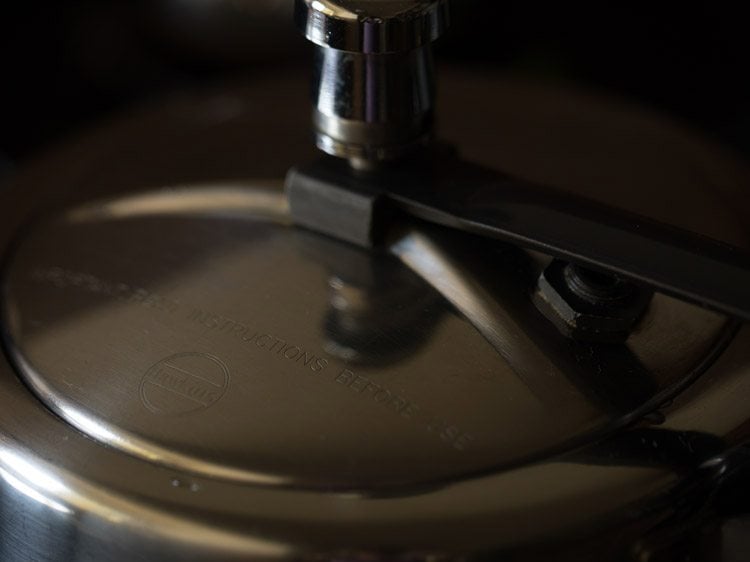
5. When the pressure settles down on its own, open the cooker and check if the veggies are fork tender, softened and cooked well.
You can even steam or cook the veggies in a pan or pot. The vegetables have be to cooked completely. Set aside the vegetables with the cooked water (broth/stock) in the cooker itself.
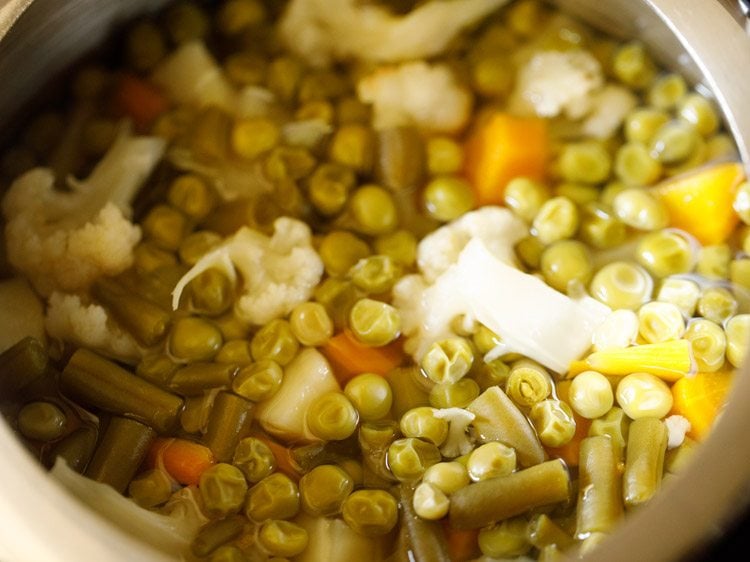
Sauté Onions, Spices
6. Heat a frying pan or kadai (wok). You can also use a large tawa or a skillet. Add 2 to 3 tablespoons butter. You can use amul butter or any brand of butter. The butter can be salted or unsalted.
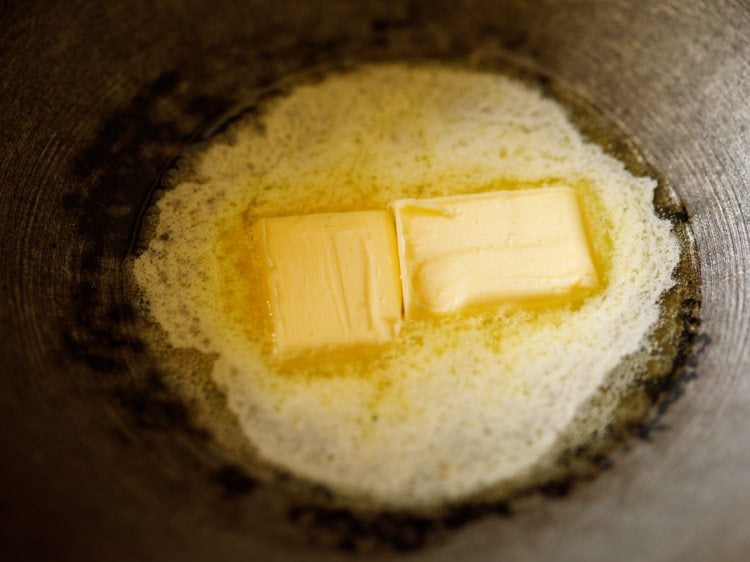
7. Let the butter melt.
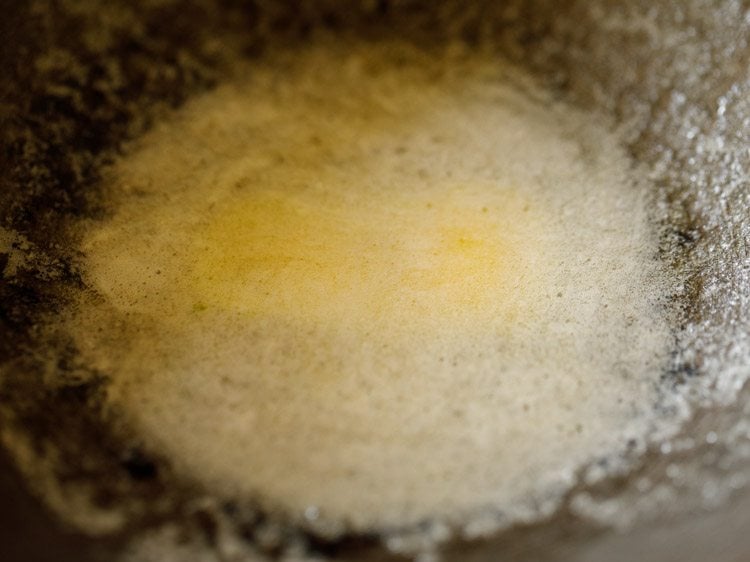
8. As soon as the butter melts, add 1 teaspoon cumin seeds.
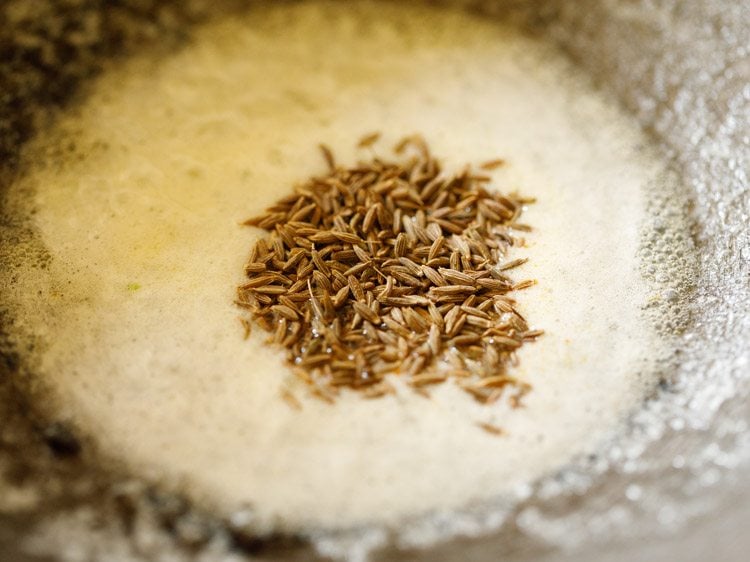
9. Let the cumin seeds crackle and change their color.
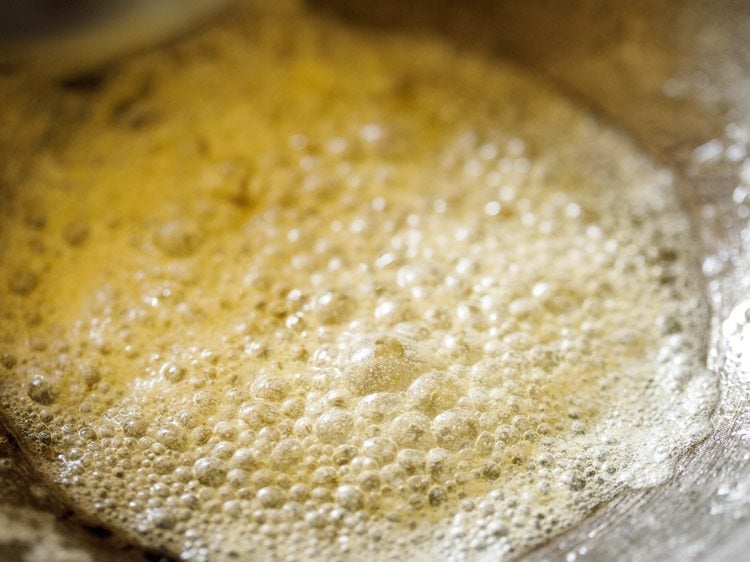
10. Then add ½ cup chopped onions.
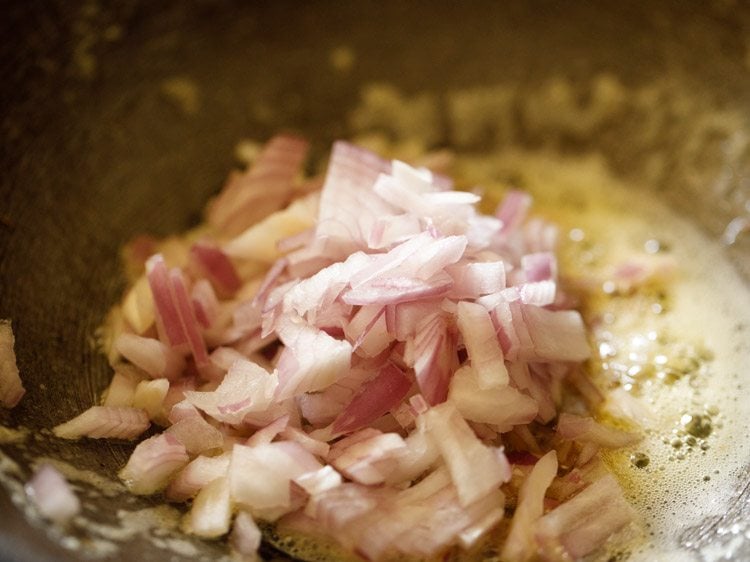
11. Mix onions with the butter and sauté on a low to medium heat.
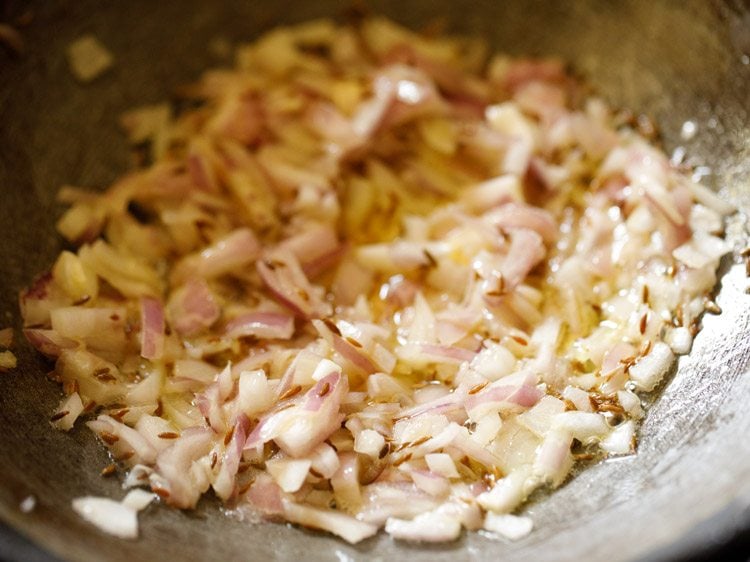
12. Sauté until the onions turn translucent.
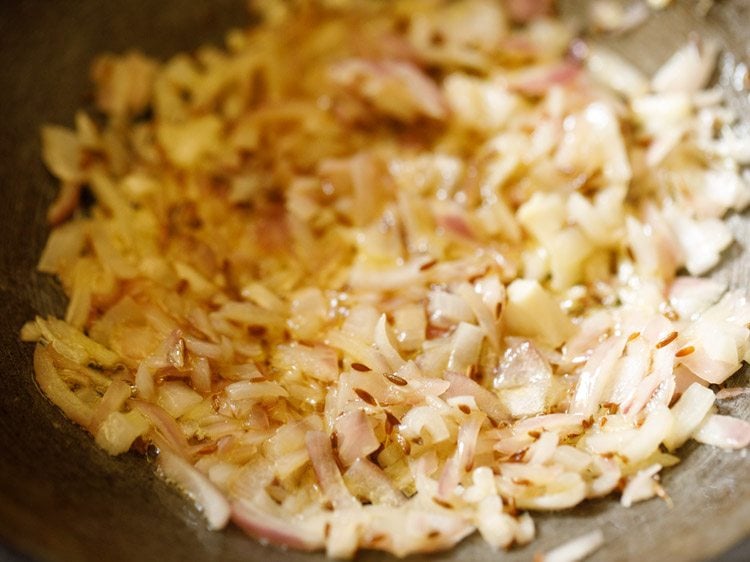
13. Add 2 teaspoons ginger-garlic paste. You can crush 1.5 inch ginger and 5 to 6 medium garlic cloves, in a mortar-pestle.
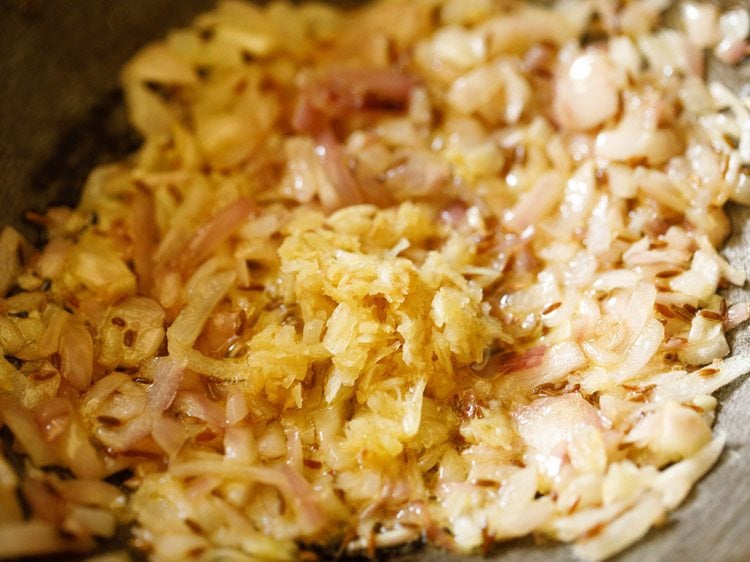
14. Mix and sauté for some seconds until the raw aroma of both ginger and garlic goes away.
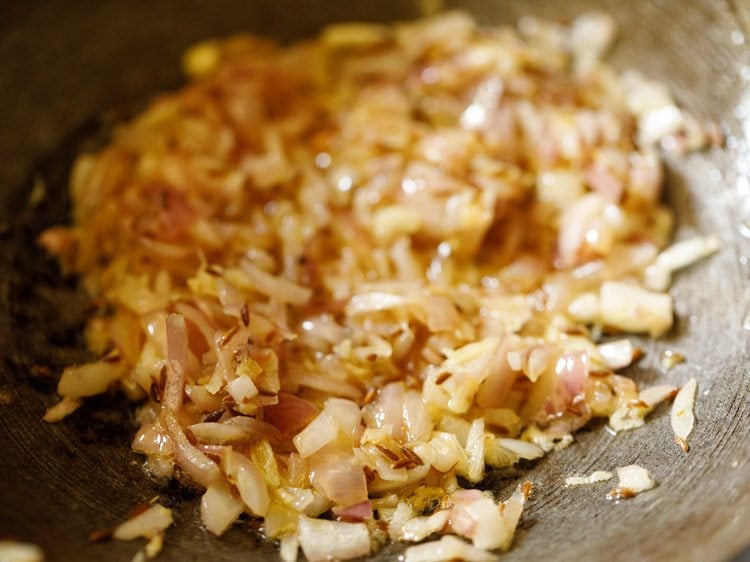
15. Then add 1 to 2 green chilies (chopped).
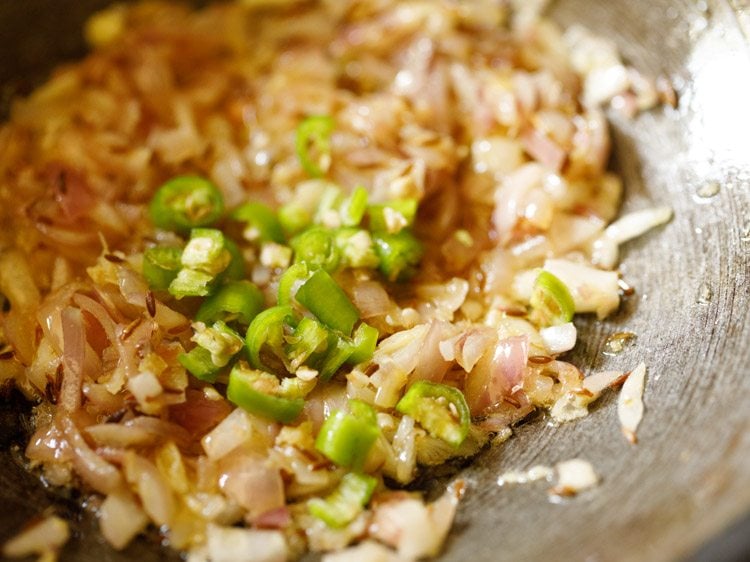
16. Mix well.
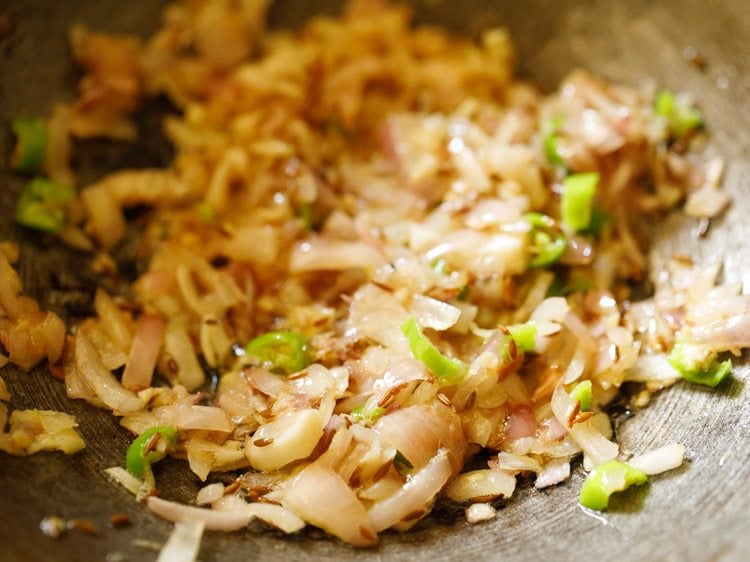
Sauté Tomatoes and Capsicum
17. Add 2 cups finely chopped tomatoes. Swap canned tomatoes if you do not have fresh tomatoes.
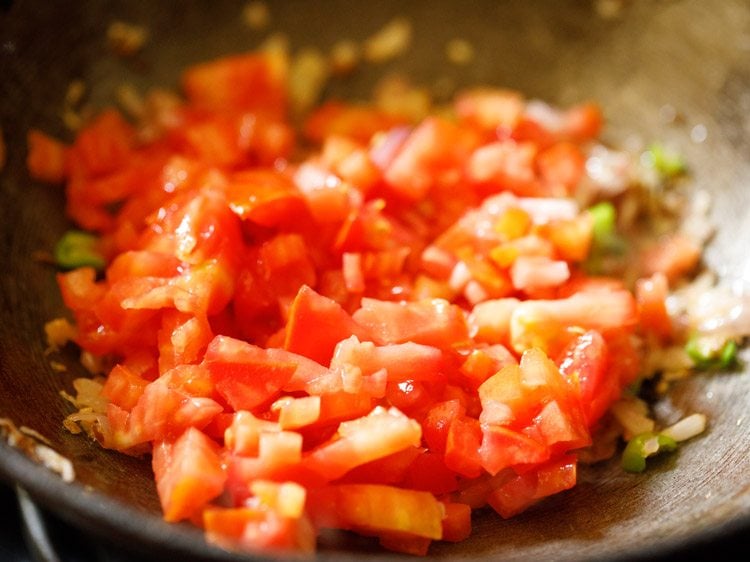
18. Mix very well.
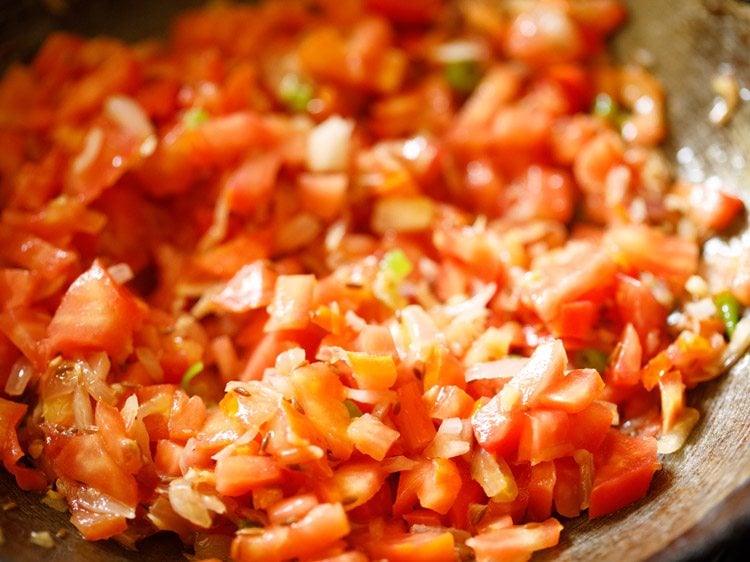
19. Then begin to sauté tomatoes on a low to medium heat.
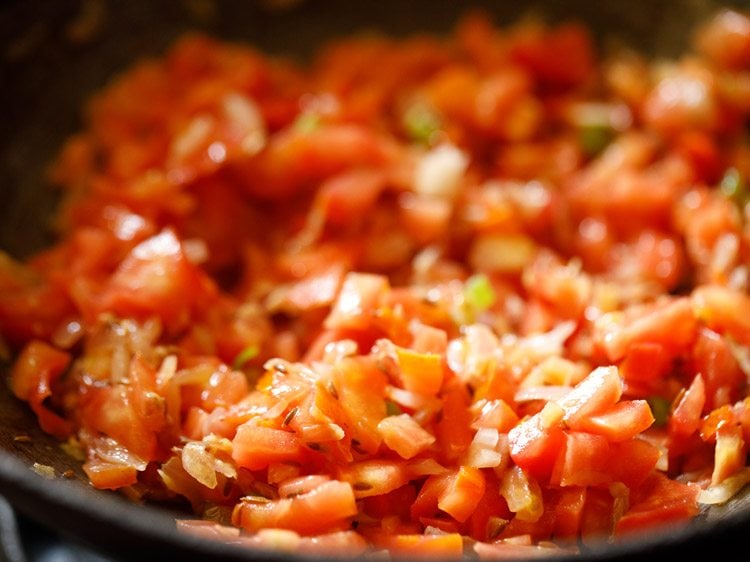
20. Sauté until the tomatoes become soft, mushy and you see butter releasing from the sides. This takes about 6 to 7 minutes on a low to medium heat.
TIP: If the tomatoes start sticking to the pan, then sprinkle some water. Mix well and deglaze the pan.
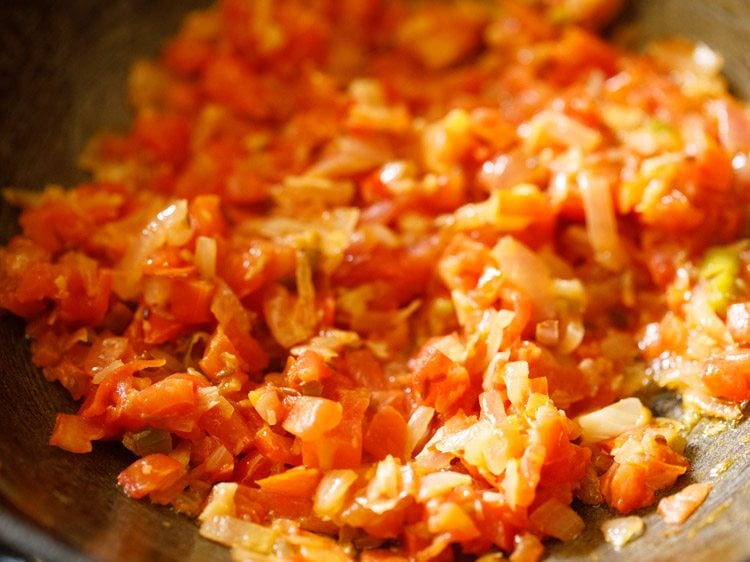
21. When the tomatoes have softened, add ½ cup finely chopped capsicum (green bell pepper). Sauté for 2 to 3 minutes.
TIP: If the mixture starts sticking to the pan, then add some splashes of water. You don’t need to cook the capsicum until very soft. A little crunch is fine in the capsicum.
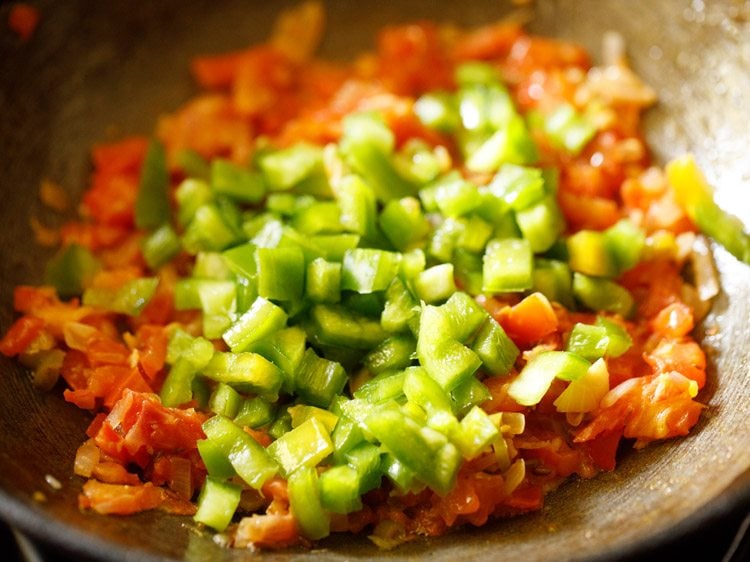
22. Add 1 teaspoon turmeric powder and 1 teaspoon Kashmiri red chilli powder.
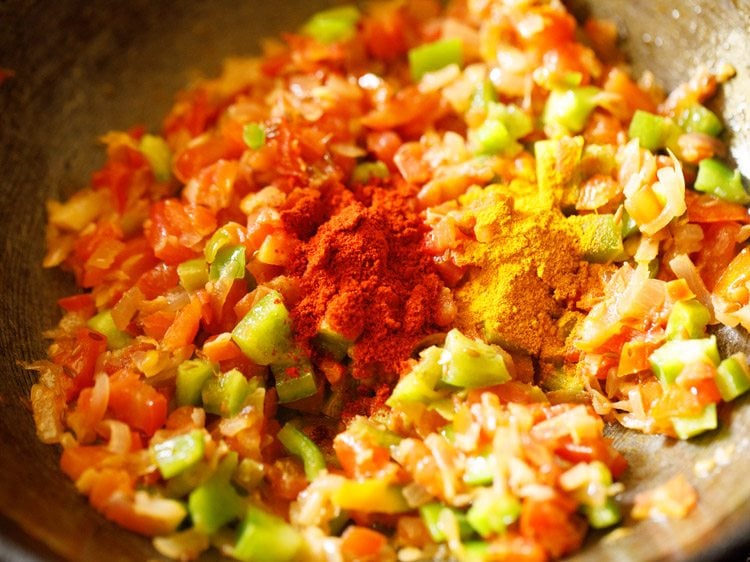
23. Add 2 to 3 tablespoons Pav bhaji Masala Powder. Depending on how instense is the aroma and flavor of pav bhaji masala, you can add it in less or more proportions.
Add 2 tablespoons if the pav bhaji masala is strong, intense and flavorful. For a more robust and spiced bhaji add 3 tablespoons of it.
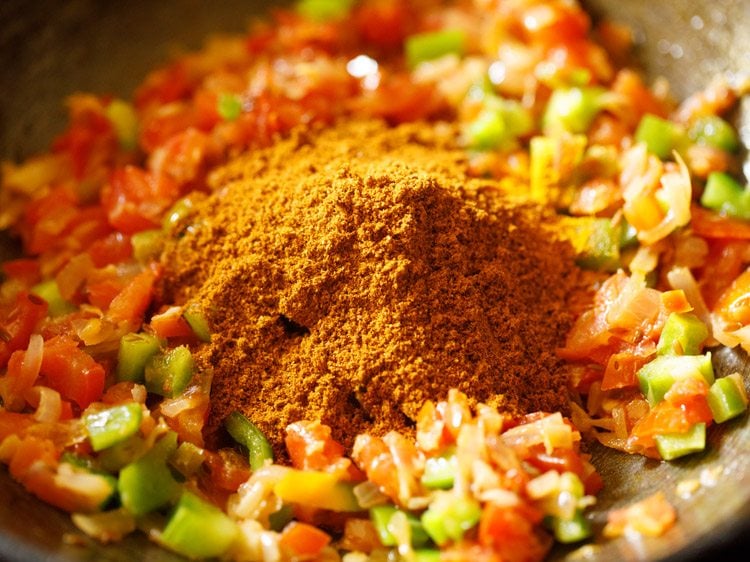
24. Mix very well.
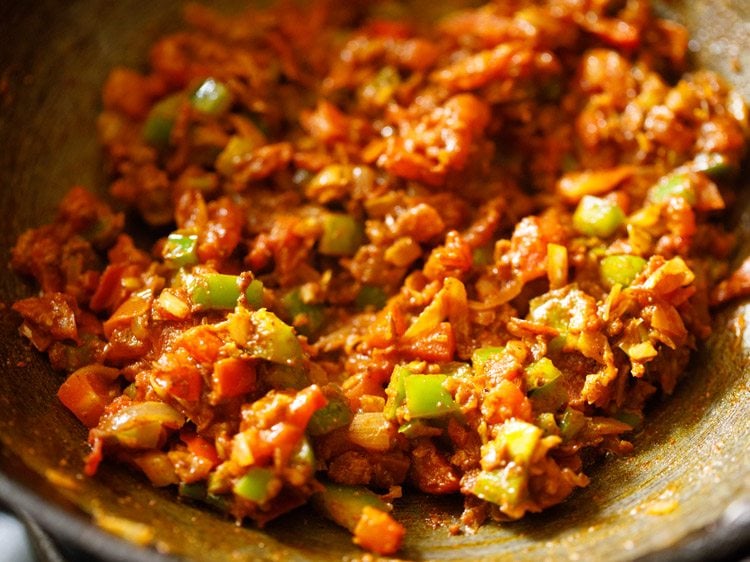
Make Bhaji
25. Add the cooked veggies. You can choose to mash the veggies before you add them in the pan or skillet.
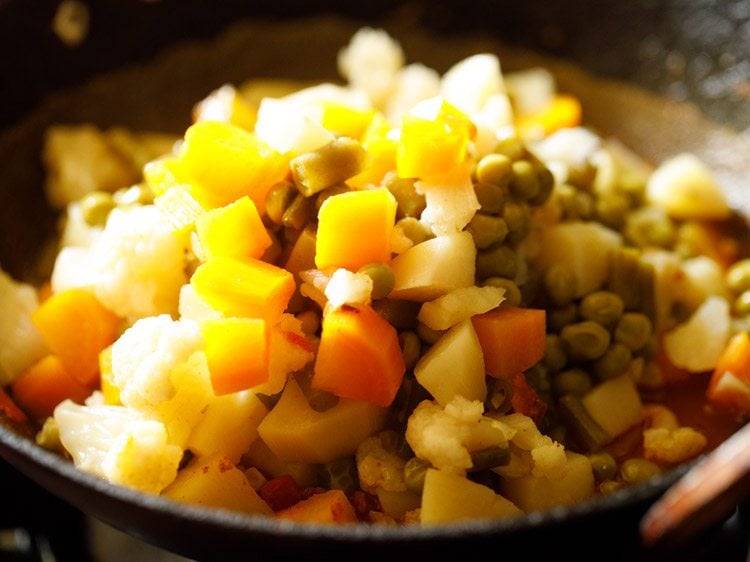
26. Mix well.
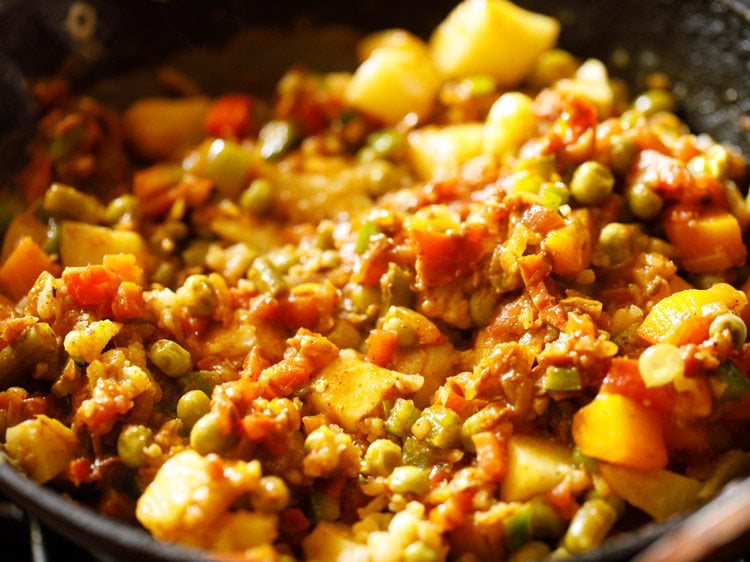
27. Add all of the stock or water from the pressure cooker in which the veggies were cooked.
28. Combine and mix thoroughly.
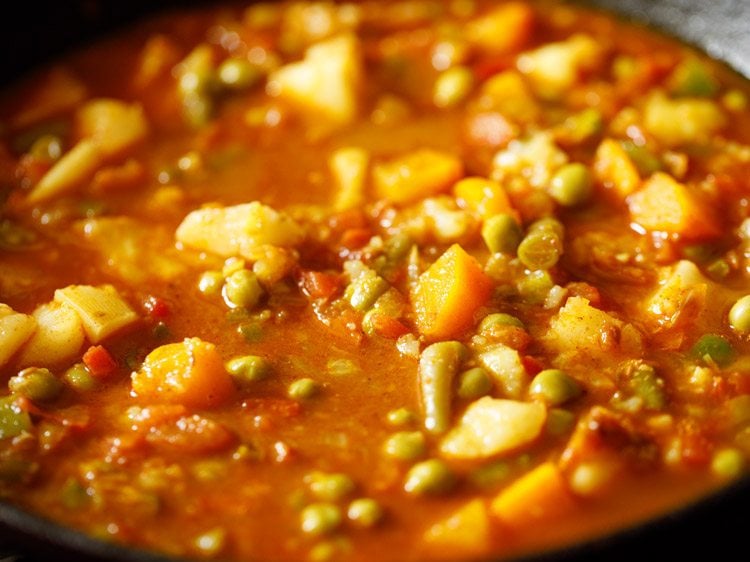
29. Season with salt according to your taste preferences and give a mix.
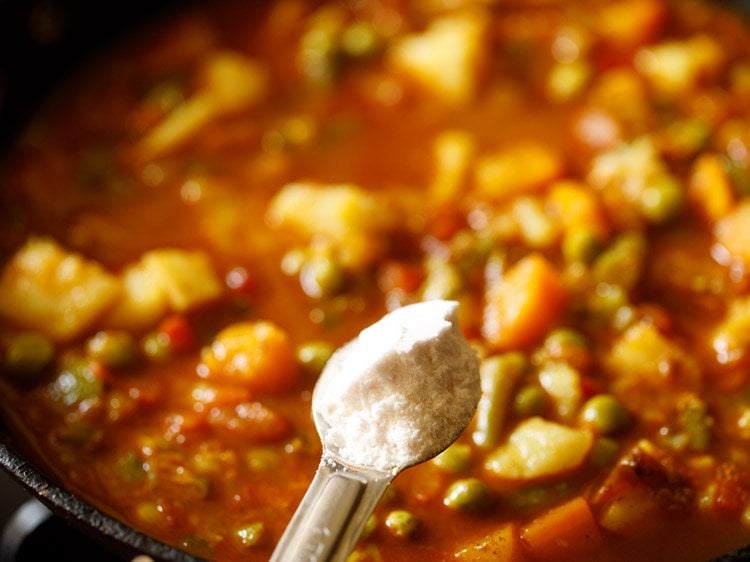
Mash Vegetables and Simmer Bhaji
30. With a potato masher, begin to carefully mash the veggies directly in the pan.
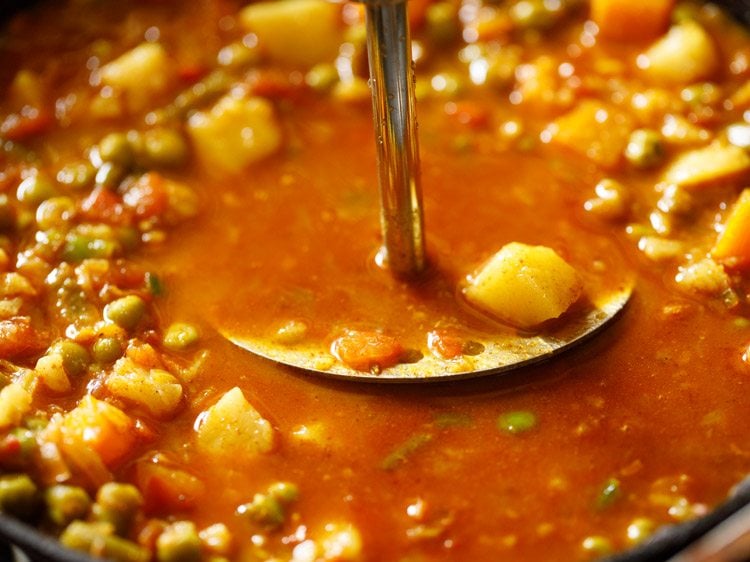
31. You can mash the veggies less or more according to the consistency you want in the bhaji.
For a smooth mixture mash more. For a chunky bhaji, mash less. Add more water if the bhaji looks thick.
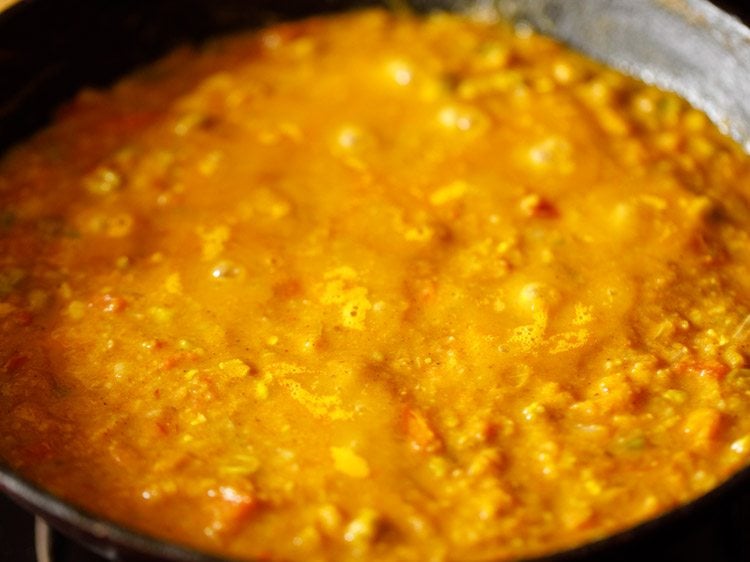
32. Keep on stirring occasionally and let the mashed vegetable gravy simmer for 8 to 10 minutes on a low heat.
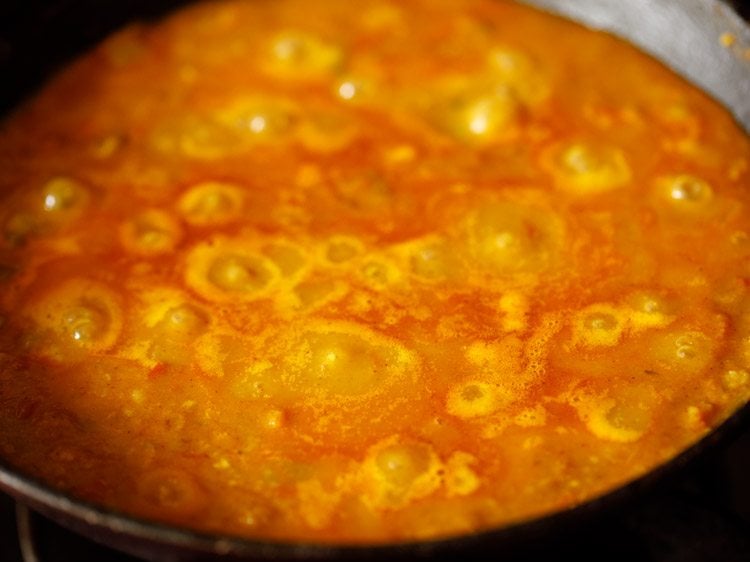
33. If the bhaji looks dry and then add some water. The consistency is neither very thick nor thin.
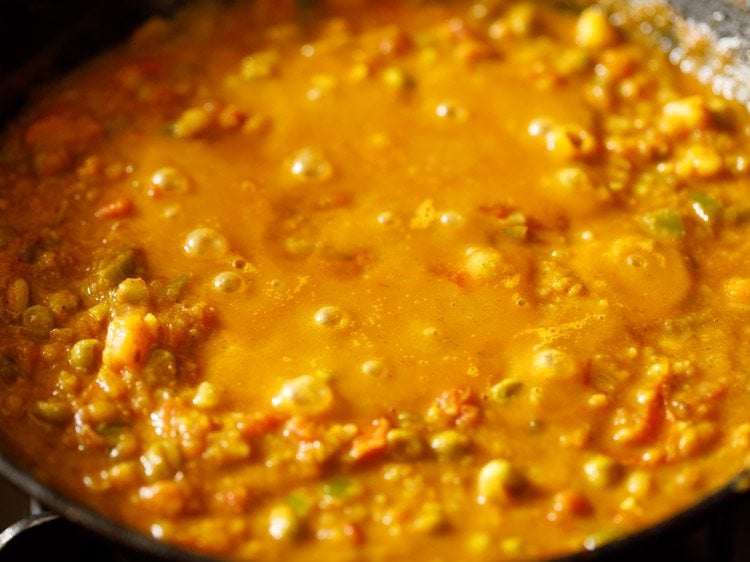
34. Do stir often so that the bhaji does not stick to the pan. When the bhaji simmers to the desired consistency, check the taste.
Add salt, pav bhaji masala, red chili powder or butter if needed.
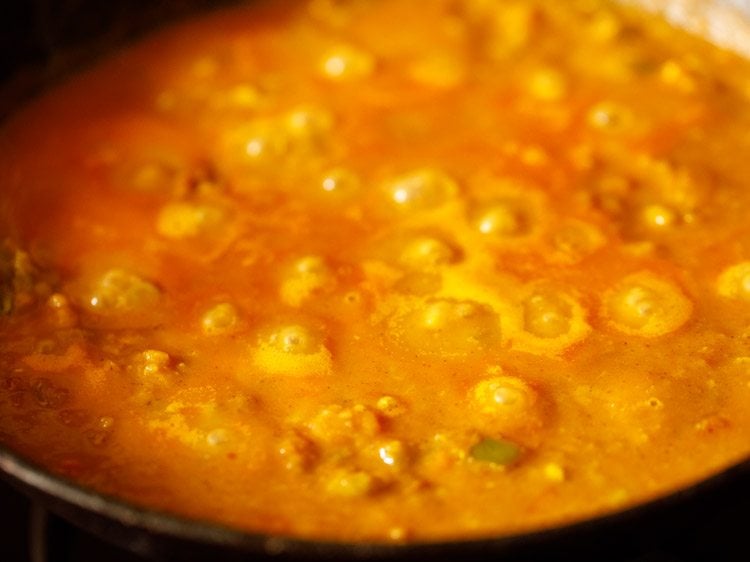
Toast Pav (Dinner Rolls)
1. When the bhaji is simmering, you can pan fry the bread rolls so that you serve the pav with steaming hot bhaji. Cut through the bread roll from the center so that you get two equal halves.
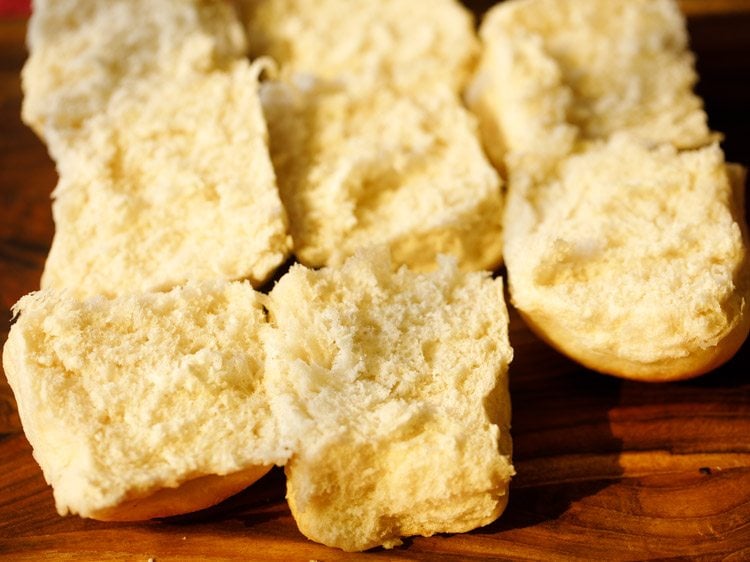
2. Heat a tawa or skillet or a shallow frying pan. Keep the heat to a low and then add 1 to 2 tablespoons butter or more if you like.
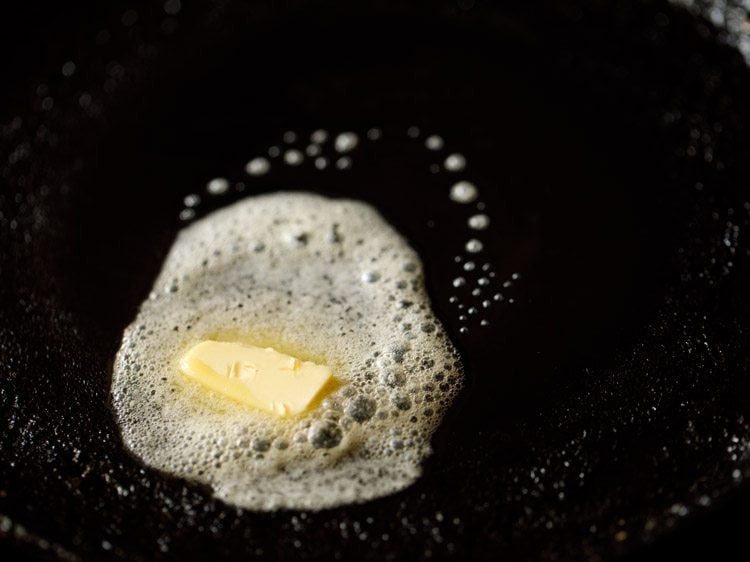
3. When the butter begins to melt, add 1 teaspoon of pav bhaji masala (for 2 to 3 pav). You can skip pav bhaji masala if you prefer.
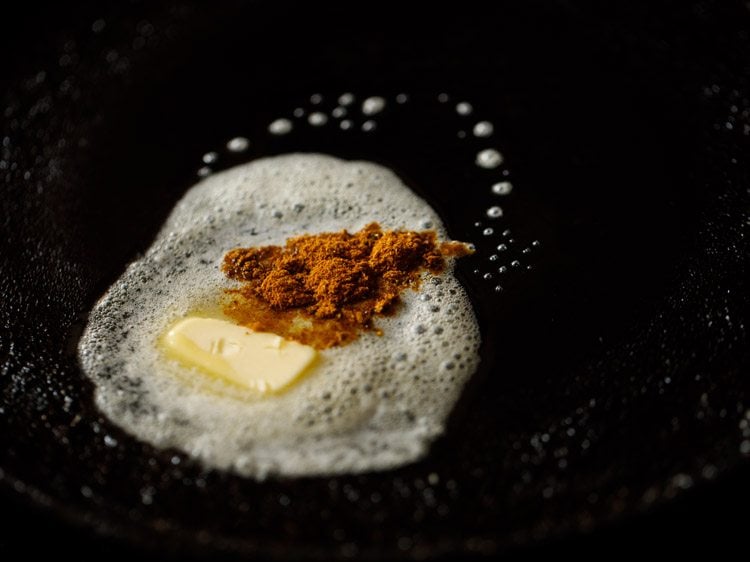
4. Mix the pav bhaji masala very well with a spoon or spatula.
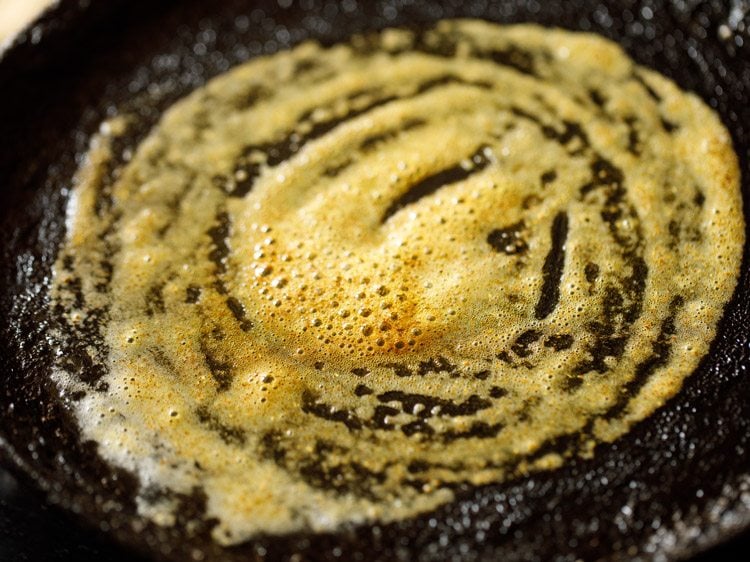
5. Then place the pav on the butter.
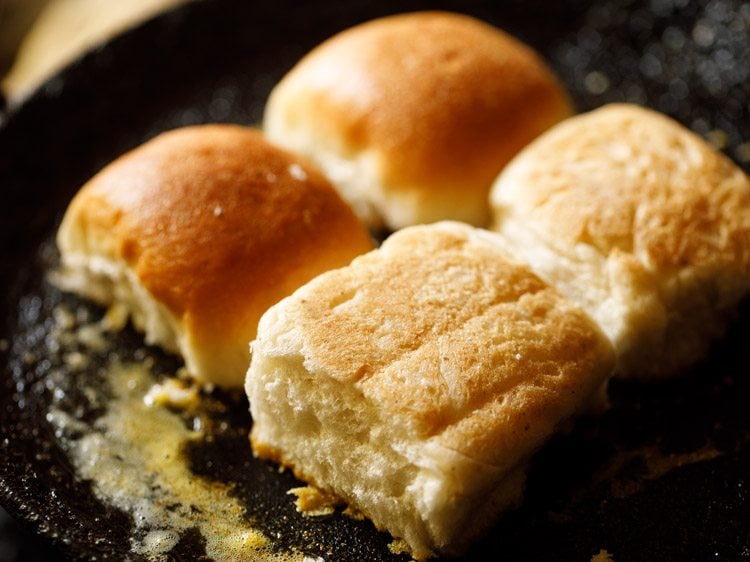
6. Press with a spatula and rotate the pav all over the melted butter so that the pav absorbs the butter together with the ground spices.
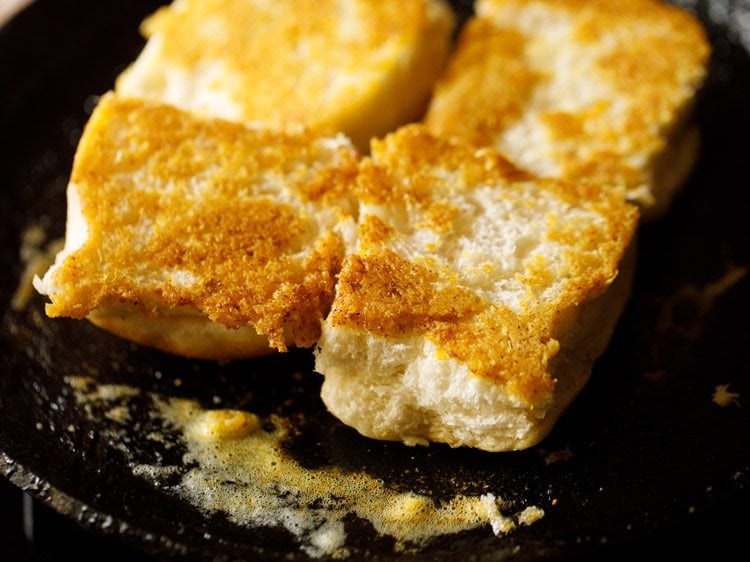
7. Now turn over the pav. Press gently with a spatula and rotate them on the tawa so that the second side absorbs the butter.
Add more butter if needed. You can turn over and toast them more if required. Then transfer the lightly pan fried bread rolls in a plate and set aside. This way fry the rolls in two to three batches.

8. Serve piping hot Bhaji topped with a bit of butter paired with the lightly toasted pav and a side of finely chopped onions, coriander leaves and lemon wedges.
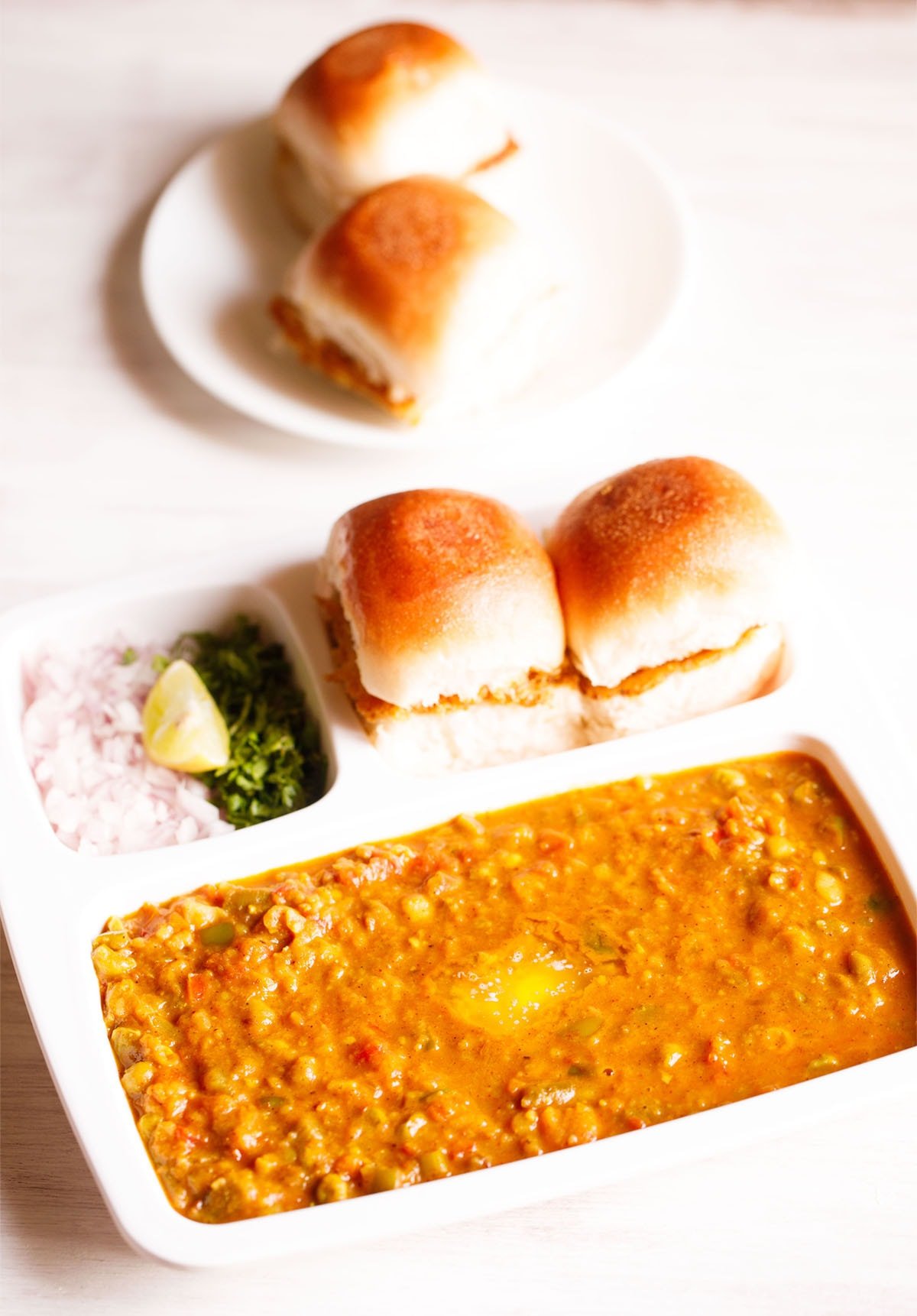
Instant Pot Pav Bhaji Recipe
This is a quick and easy method of preparing this delicious street side snack in an electric pressure cooker or instant pot.
There are times when I make pav bhaji in the instant pot. So I thought I will share this method here. It is easy and saves time. So when in a hurry or when you have unexpected guests, you can consider making it in the instant pot.
In the instant pot the cooking method is different. Unlike the street-side stalls where this dish is made on very large tawa (a flat griddle), in the instant pot everything is cooked together that saves time.
Bhaji Ingredients
2 to 3 tablespoons butter, salted or unsalted
½ teaspoon cumin seeds
½ cup finely chopped onions
2 teaspoons Ginger Garlic Paste
1 teaspoon chopped green chilies
2 cups chopped tomatoes
⅓ cup chopped capsicum
2 cups chopped potatoes
¾ to 1 cup chopped cauliflower
¾ cup chopped carrots
¼ cup chopped french beans, optional
½ cup green peas, fresh or frozen
½ teaspoon turmeric powder
1 to 1.5 teaspoons kashmiri red chilli powder
1.25 cups water
salt as required
2 tablespoons Pav Bhaji Masala
1 to 2 tablespoons butter – to add later
2 tablespoons chopped coriander leaves (cilantro)
To serve With Bhaji
12 pav (dinner rolls) or as needed
3 to 4 tablespoons butter – for toasting pav
1 lemon or lime, chopped in wedges
1 onion – medium to large, finely chopped
3 to 4 tablespoons chopped coriander leaves – for garnish
2 to 3 tablespoons butter – for topping, add more for a richer version
Prep Vegetables
1. Firstly rinse all the vegetables. Peel the veggies which need peeling. Chop all the veggies and keep them ready.
You can add your choice of veggies. I have used a mix of potatoes, cauliflower, carrots, french beans, peas and capsicum.
Chop the carrots, beans, cauliflower, potatoes in small cubes or pieces so that they get cooked faster.
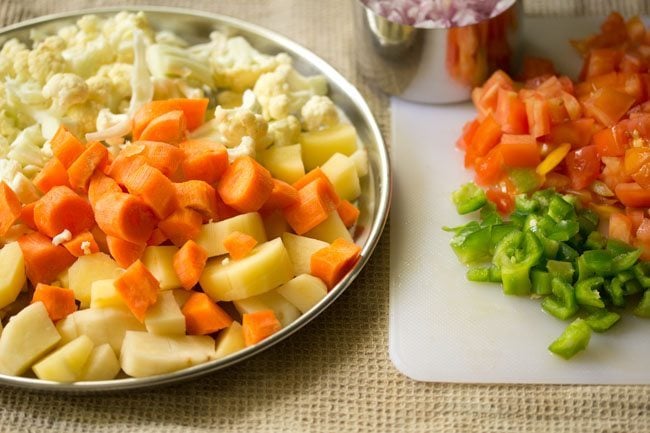
2. Switch on the instant pot. Press the saute button on less mode.
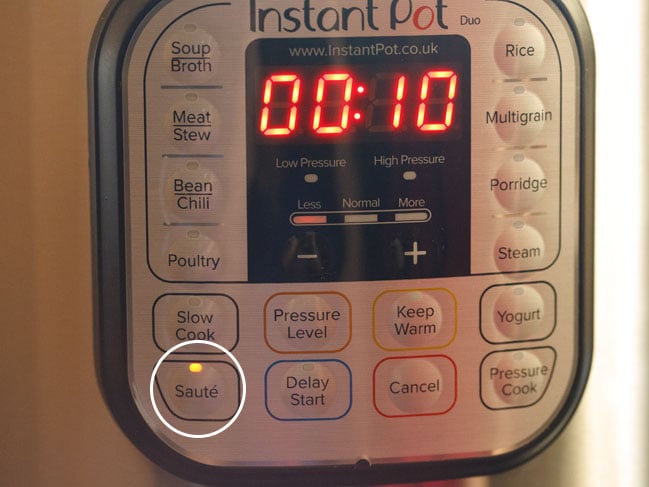
Sauté Spices and Onions
3. Add 2 to 3 tablespoons butter in the IP steel insert.
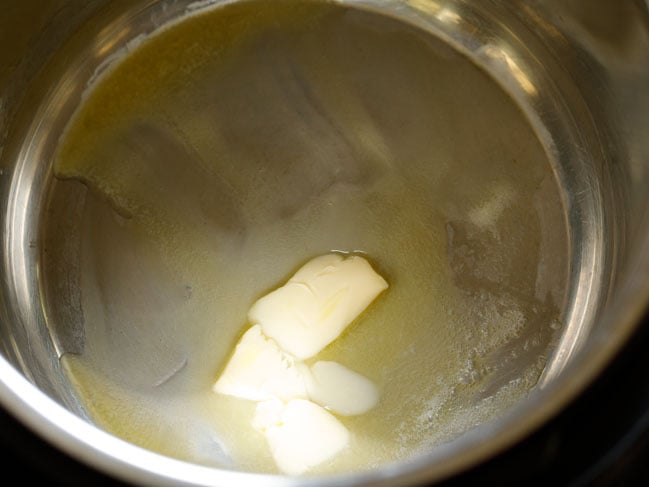
4. When the butter melts, add ½ teaspoon cumin seeds and let them splutter and change color.
5. Then add ½ cup finely chopped onions.
7. Next add 2 teaspoons ginger-garlic paste and 1 or 2 chopped green chillies.
8. Stir and sauté for a few seconds until the raw aroma of ginger-garlic goes away.
Sauté Veggies
9. Then add 2 cups chopped tomatoes and ⅓ cup chopped capsicum (green bell pepper). Sauté for 1 to 2 minutes.
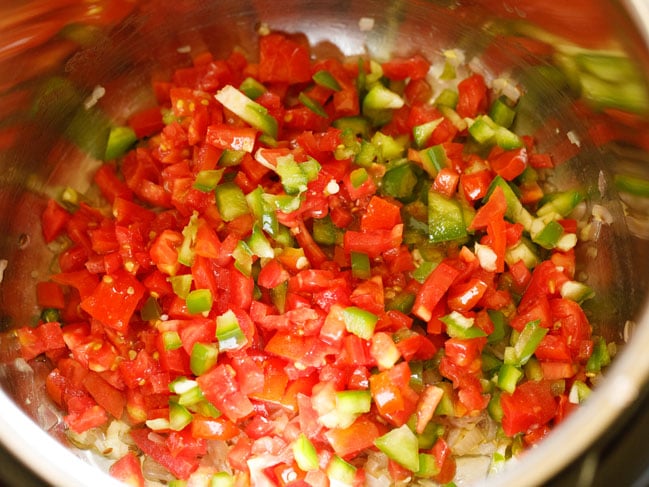
10. Add the chopped veggies and green peas.
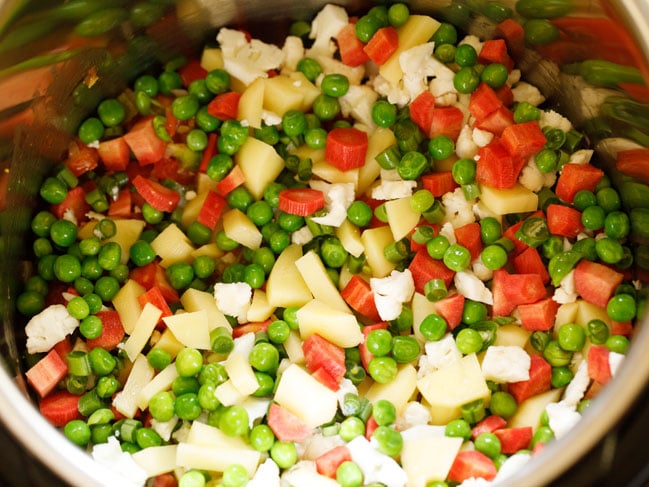
11. Add ½ teaspoon turmeric powder and 1 to 1.5 teaspoons Kashmiri red chilli powder. If using any other red chilli powder or cayenne pepper, then you can add less of it.
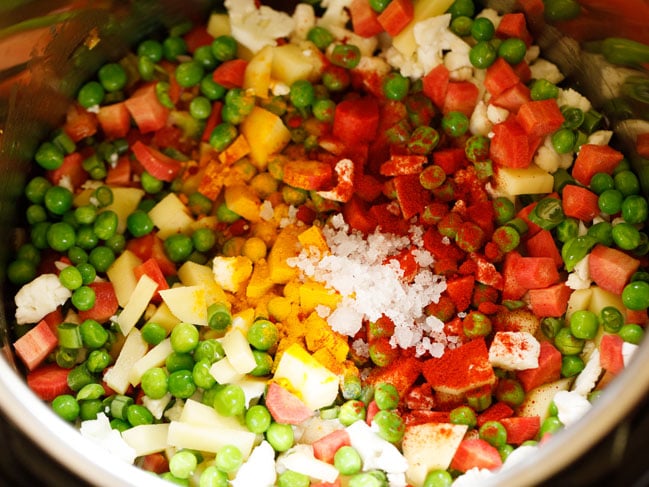
12. Mix everything very well. Deglaze while mixing so that any ingredients stuck at the bottom of the pan is removed. The moisture from the vegetables helps in deglazing.
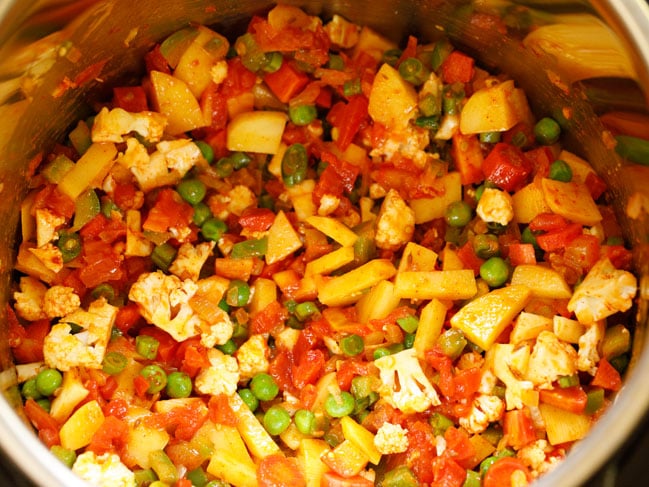
Pressure Cook Vegetables
13. Add 2 cups of water. Stir again. Deglaze if required.
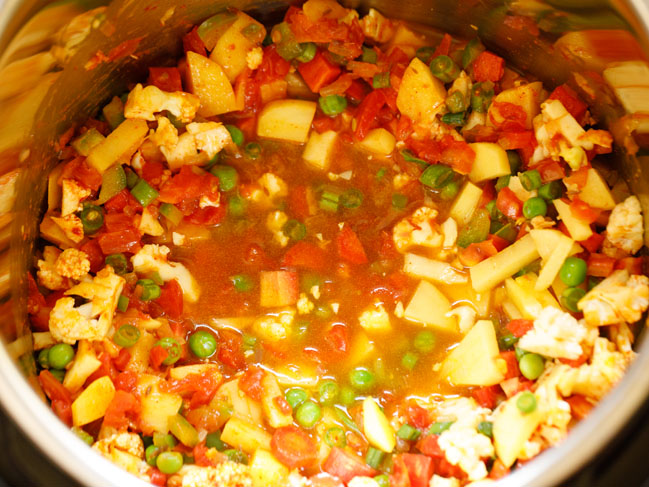
14. Press the cancel button. Now press the pressure cooker/manual button and set time to 7 minutes on high pressure.
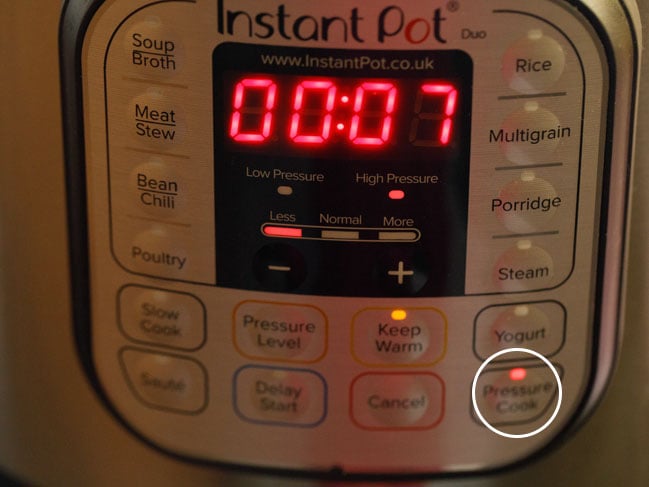
15. When the beep sound is heard and the pressure cooking is complete, do a quick pressure release (QPR). When all the pressure is released, open the lid.
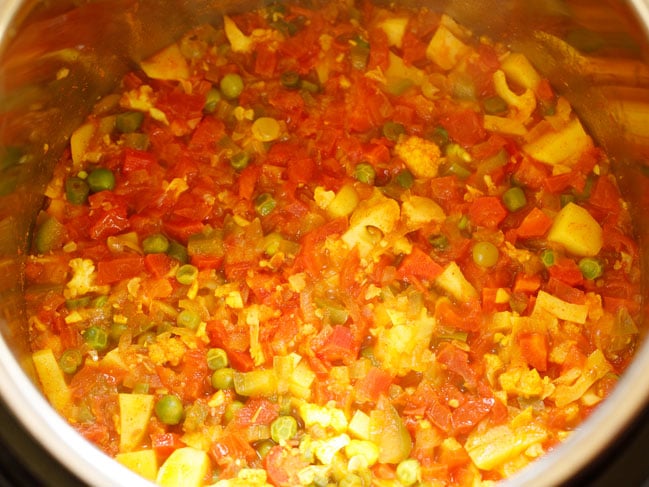
Mash Veggies
16. Using a napkin or oven mittens, remove the steel insert from the instant pot. Place it on your kitchen counter. With a potato masher, begin to mash the cooked vegetables.
Mash very well. You can even use an immersion blender and puree the veggies to a semi-fine consistency.
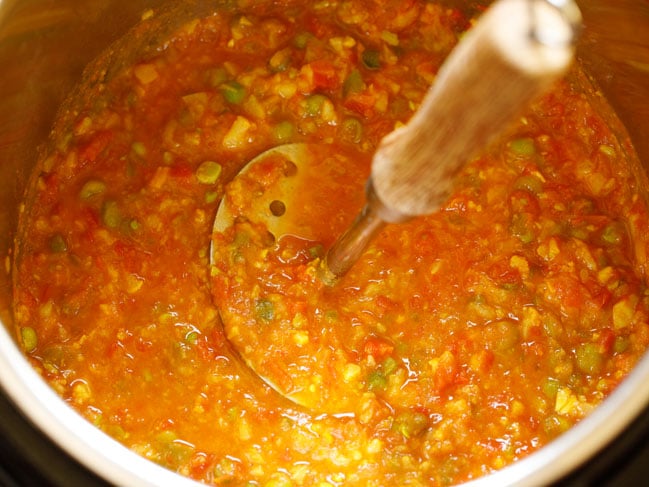
17. Now add 2 tablespoons pav bhaji masala and 1 to 2 tablespoons butter. You can skip the butter if you want. Mix very well.
18. Place the steel insert pan in the IP. Press the cancel button and then press the sauté button on normal mode. Set the timer to 3 to 5 minutes or more.
19. Simmer the bhaji for a few minutes, till it thickens a bit. Stir often, so that the bhaji does not stick to the bottom. If the bhaji looks very thick, then add some water.
20. Simmer till you get the desired consistency.
21. Sprinkle 2 tablespoons chopped coriander leaves. Mix very well.
Do check the taste and add salt, butter, Kashmiri red chili powder or pav bhaji masala if required. Cancel and keep the IP mode on warm.
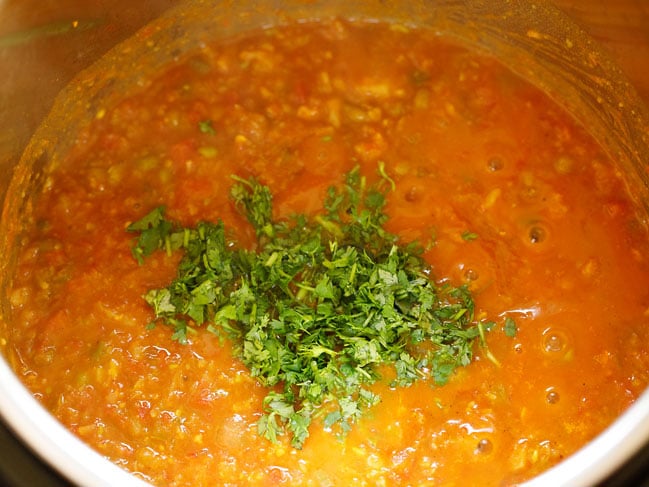
Pan Fry or Toast Pav
22. For the pav, heat a tawa or griddle and melt some butter on it. Place sliced pavs (dinner rolls) on it.
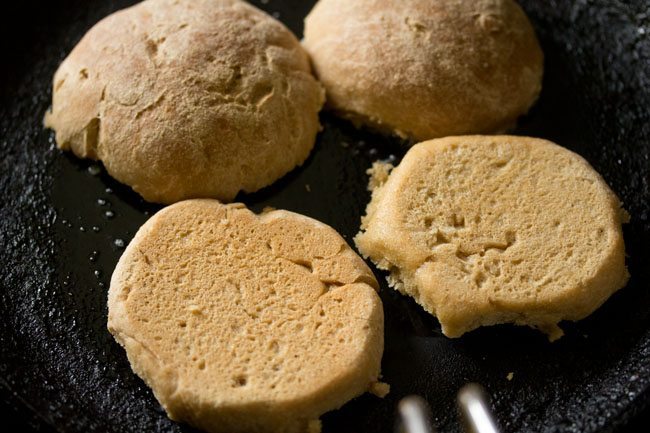
24. Let the pav soak the butter and become warm. If you want you can even lightly toast the pavs.
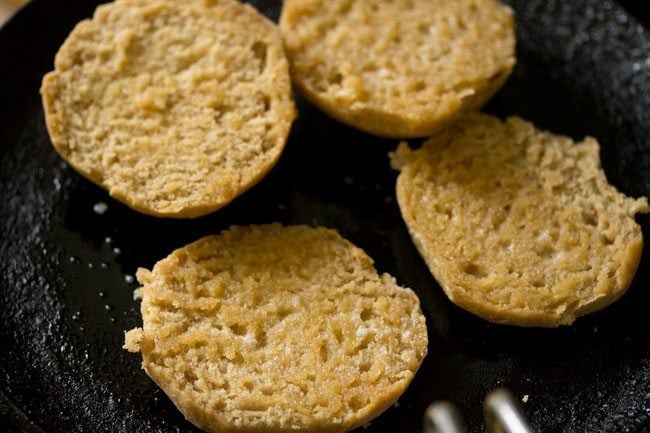
How to serve Pav Bhaji
Whether you have made the pav bhaji recipe with the traditional method or in an Instant pot, it is now time to serve and enjoy it. Here is how Mumbai pav bhaji is served if you are new to this dish.
- Pour the vegetable gravy in a bowl. Top it up with one to two cubes of butter. You can add more butter, if you like.
- Place a side of finely chopped onions, lemon wedges and finely chopped coriander leaves. Or you can sprinkle onions, coriander leaves and lemon juice directly on the bhaji.
- The bhaji is topped with chopped onions, coriander leaves and the lime or lemon juice is squeezed on the bhaji and then eaten with dinner rolls aka Pav. To lighten up your palate, you can consider to serve pav bhaji with a cooling Cucumber Raita.
- Serve bhaji with the lightly pan fried and buttered pav.
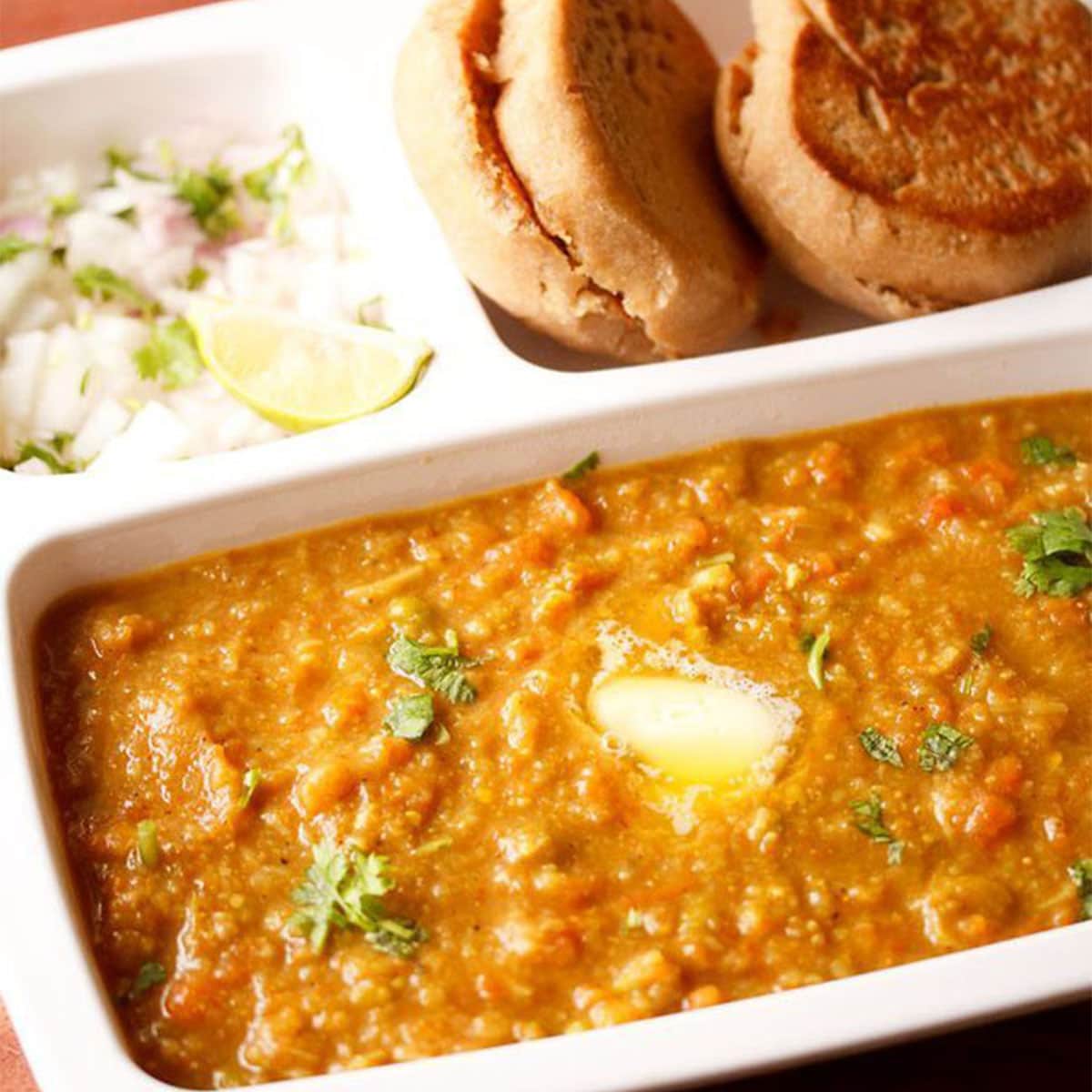
No comments:
Post a Comment